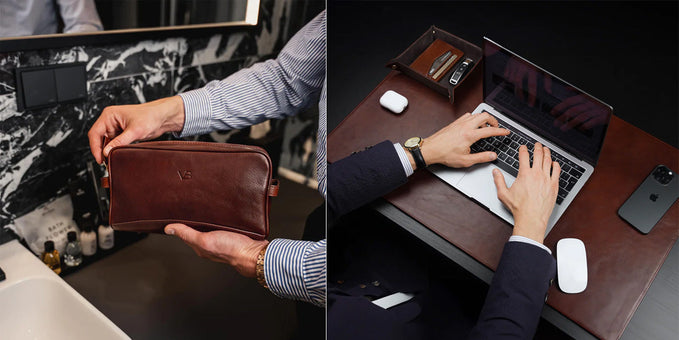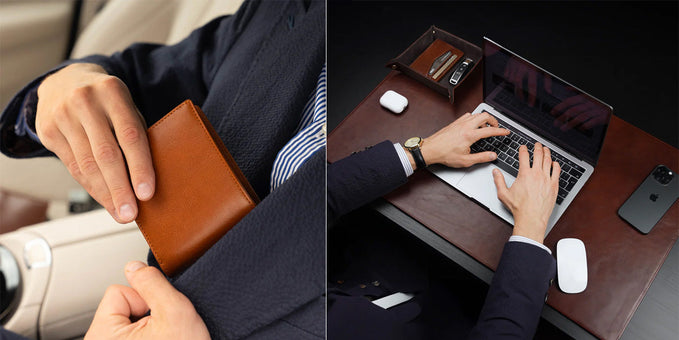Briefcase Compartments

Here's a quick summary of how to decide on briefcase pockets/compartments:
- Empty your current work bag and prioritize what you actually need, how often you need it, and where you'd like it located in your briefcase.
- Repack and repeat for all common scenarios (such as business travel, commuting, client meetings, etc).
- Then use that info to list the pockets and compartments your briefcase needs,
- This could include padded sections for tech, accordion files for documents, quick-access pockets, and secure spaces for valuables.
- Modular or expandable designs keep your items organized (such as business travel, commuting, client meetings, etc. and accessible, even with a changing routine.
Prefer video? See our briefcase video guide:
Read more details and see examples below:
Identify and Prioritize Your Key Essentials

Image shows common briefcase essentials with a Majestic Valet Tray and an Executive Large Desk Pad.
What do you carry, and how do these items define your day?
Begin by categorizing the items you always carry.
These usually fall into four major groups:
- Technology: Laptops, smartphones, tablets, and their accessories.
- Paperwork: Contracts, notes, reports, or presentation materials.
- Personal Comfort: Wallets, snacks, keys, water bottles, or toiletries.
- Accessories: Pens, earbuds, business cards, or portable chargers.
How to Create a Carry Priority Map
Assign a hierarchy to the items you carry:
- Urgent access: Items you use the most frequently, such as your keys, phone, and pens.
- Moderate access: Things you use less frequently but still require every day, like notebooks or chargers.
- Occasional use: Items you need but don’t access too often, like spare cables or batteries.
Once you understand what’s the most essential and how regularly you reach for it, you’ll know exactly which pockets and compartments you need and where they should be.
Here's an example of how we pack the CITY Large Leather Laptop Bag:
Example: Imagine that you’re in a rush to catch a train and need quick access to your ticket. If you have a designated exterior pocket, you can cut down on stress and won’t need to fumble at the last section.
We also have a detailed guide on how to organize your briefcase here.
Choosing the Best Compartments for Tech Needs

Image shows the internal compartments of the No.1 and Essential briefcases.
Are electronics a major part of your life?
Tech equipment is essential for most professional workers these days, but it's fragile, so you need a briefcase with a dedicated padded compartment to protect it while you're on the move.
Features to Look For in a Tech-Ready Bag
- Padded Sleeves: Make sure that the padding extends fully, including the bottom. Drops can damage the edges of laptops or tablets.
- Built-In Cable Ports: Look for sections that enable charging on the go, with discreet openings for your cords.
- Shock Absorption: Some areas have shock-resistant materials built into them, safeguarding devices from impact.
- Weatherproofing: Sealed zippers or water-resistant lining can protect your electronics from rain exposure and accidental spills.
- Scratch-Resistant Linings: Smooth and padded materials can prevent internal scuff marks on cases and screens.

Image shows the external pockets of the CITY and No.1 bags.
Pro Insight: During an incredibly important pitch, a colleague of mine found it hard to get everything set up as their charger was tangled up and located at the bottom of their bag. They could have saved a great deal of time and tension by using an organizer pocket that was designed especially for adapters and cables.
Additional Tip
Do you switch between devices regularly? If so, you could purchase a briefcase with dual-access compartments. With quick side access, you can get hold of your tablet quickly without having to unpack all the contents of the briefcase.
Learn more about types of briefcases here.
Organize Paperwork Professionally

Image shows the internal compartments of the No.2 and Elegant bags.
Are loose papers making your workflow cluttered?
Even in today’s digitally-focused world, many professionals are still dependent on printed documents.
However, disorganized paperwork can create unnecessary stress, waste time, and stop you from making the right impression.
Advanced Document Organization Techniques
- Dedicated File Sections: Choose accordion-style dividers with tabs. Assign categories like "To Review," "Pending Action,” or “Signed.”
- Flat Slip Pockets: Use these for single sheets that must remain crisp, like client proposals or legal documents. Seek out reinforced edges to prevent tearing.
- Hidden Security Pockets: Store confidential papers, such as contracts, in zippered or inner pockets so they remain private.
- TSA-Friendly Compartments: Travelers handling documents can save time when going through airport security by using compartments designed to fold flat.
Example: I once knew a lawyer who had been using color-coded compartments for many years. They had a setup with compartments that were wide enough to hold multiple labeled folders. This enabled them to remain calm and keep chaos to a minimum.
Practical Insight
A slim zippered pouch can be helpful if you’re worried about losing essential documents like receipts or confidential paperwork. These can be highly efficient when it comes to keeping on top of travel itineraries or expense tracking.
Interested in browsing other options? See all Von Baer briefcases here.
Design Compartments for Greater Personal Comfort

Image shows the external slip pocket of the CITY Large.
How do small conveniences improve your day?
Briefcases aren’t just tools for work - you should see your briefcase as a reflection of your personal lifestyle.
With personal compartments, you can remain ready for the unexpected and stay comfortable throughout your working day.
Essential Personal Compartments
- Dedicated Water Bottle Holder: Choose a section that’s designed to prevent leaks and has elastic or insulated linings.
- Quick-Grab Pockets: Store essentials like tissues, lip balm, or hand sanitizers. Ensure these areas are easily accessible, particularly during commutes.
- Expandable Snack Section: Look for compartments that have stretchable mesh and can adapt to different items you’re storing while keeping them contained.

Image shows the external pockets of the Essential and CITY bags.
When you attend a morning meeting, and it is extended into lunchtime, things get much easier when you can discreetly grab a snack and, therefore, maintain your energy and focus.
Maintenance and Cleaning
- Removable Linings: Compartments that have removable or washable liners make cleaning spills easier and quicker
- Stain-Resistant Materials: These are great for storing food or toiletries.
- Conditioning Leather: Leather needs to be regularly conditioned to stay in good condition. We recommend using this Premium Leather Cream.
Expert Tip
Think about buying a bag that has odor-resistant linings if you’re always on the move. This feature is particularly great for people who regularly carry snacks and gym clothes but want to minimize unpleasant odors.
Get Control of Small Accessories

Image shows an internal pen holder, alongside the Elegant briefcase.
How do tiny items cause major headaches?
Misplacing business cards and loose pens can stop you in your tracks.
When you have access to specialized compartments for these small items, you can prevent these problems before they occur.
Advanced Accessory Management
- Pen Loops with Elastic Grip: Stop pens from slipping out by choosing loops that are designed to hold various sizes snugly.
- Micro Compartments: Seek out padded mini-pockets specifically crafted for USB pens or wireless earbuds to prevent loss and protect your delicate electronics.
- Clear Window Pockets: These are ideal for ID cards or frequently accessed small items as they increase their visibility, making them easy to find.
Real Story: A few years ago, I reached inside my bag and accidentally handed somebody a scuffed business card. Learning my lesson, I later purchased a bag with a dedicated cardholder, so this never happened again.
Adapting Through Modular Features

Image shows the modular compartments of the 10X which converts between a backpack, briefcase, and travel bag.
Do your needs change throughout the week?
If you have a static layout, this can limit flexibility. Choose a modular design that can easily adapt to a shifting routine.
Key Modular Features to Look For
- Removable Panels or Dividers: Adjust sections so they can accommodate everything, from extra clothes for overnight trips to think binders.
- Expandable Gussets: These give you more room when you need them, such as when you’re transporting bulky items home following a conference.
- Convertible Compartments: Some designs transform entirely. You can use some items as messenger bags for casual use or expand them into carry-ons for travel.
- Luggage Straps: These attach your bag to a rolling suitcase to make transport easier.
Here's how the 10X Convertible Backpack Briefcase works:
Example: I once saw a colleague seamlessly transform her work briefcase into a travel-ready backpack simply by unzipping its hidden compartments. She was able to pack toiletries, a blazer, and shoes and still keep her laptop and documents perfectly organized.
Expert-Level Insight
If you’re considering a modular design, make sure that you test the zippers, snaps, or Velcro attachments before you buy. Weak closures often fail over time and, therefore, cause spills or lost items.
Tailor Your Setup to Match Up With Your Life
Your organizational system isn’t just a storage device.
When you have a firm understanding of your habits, requirements, and challenges, your everyday carry can become your invaluable partner.
It can ensure that you’re always in control and can remain prepared and professional at all times.
Let the right item become the solution you can depend on each day to help you complete your challenges with ease.
Read our related guide on briefcase colors here.

Author: Igor Monte
Igor Monte is the co-founder of Von Baer. He's an expert in all things premium leather, from being an end-user right up to the design and manufacturing process. His inside knowledge will help you choose the best leather product for you.
We strive for the highest editorial standards, and to only publish accurate information on our website.
Leave a Comment
Your email address will not be published.






